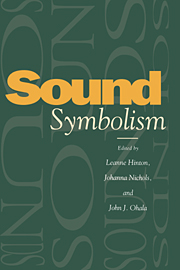Book contents
1 - Introduction: Sound-symbolic processes
Published online by Cambridge University Press: 04 August 2010
Summary
Hermogenes. I should explain to you, Socrates, that our friend Cratylus has been arguing about names; he says that they are natural and not conventional; not a portion of the human voice which men agree to use; but that there is a truth or correctness in them, which is the same for Hellenes as barbarians.
PlatoIntroduction
In general, linguistic theory assumes that the relation between sound and meaning is arbitrary. Any aspect of language that goes against this assumption has traditionally been considered as only a minor exception to the general rule. Over the past few decades, there has been a great accumulation of cross-linguistic data on sound symbolism. Recently, scholars interested in sound symbolism came together at a conference to attempt to synthesize the data and discuss its implications, in order to begin the determination of the rightful role of sound symbolism in a theory of language. The papers in this volume represent the findings of the conference. We must conclude, from the combined work shown here, that sound symbolism plays a considerably larger role in language than scholarship has hitherto recognized.
In this introduction, we will examine the nature of sound symbolism in general. The term “sound symbolism” has been used for a wide array of phenomena in human languages, related but each with its own distinguishing characteristics. We will begin, then, with a typology of sound symbolism. We then explore the general characteristics of sound-symbolic form and meaning.
- Type
- Chapter
- Information
- Sound Symbolism , pp. 1 - 12Publisher: Cambridge University PressPrint publication year: 1995
- 26
- Cited by

